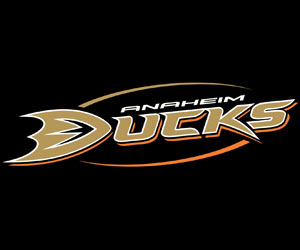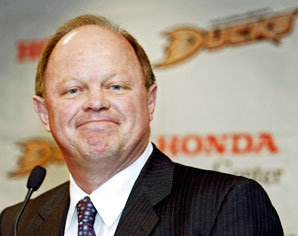Over the course of the off-season, I’ll be examining the essential questions facing the Anaheim Ducks in the 2012-13 season, as they look to regain elite standing in the league. Stay tuned as the pieces start to role out!
Management vs. Coaching vs. The Core
 In order for a professional hockey team to have any measurable success, there are three essential elements that must function in concert with each other. They are: the management team, the coaching staff, and the core players around which the rest of the team is built. By the same token, if one examines a club that’s spiraling out of control, you can bet on at least one, if not several of these three elements being out of whack and in need of some mending.
In order for a professional hockey team to have any measurable success, there are three essential elements that must function in concert with each other. They are: the management team, the coaching staff, and the core players around which the rest of the team is built. By the same token, if one examines a club that’s spiraling out of control, you can bet on at least one, if not several of these three elements being out of whack and in need of some mending.
The main idea here shouldn’t be revelatory to anyone that has even casually followed professional sports over the course of their lives. It’s a rather simple equation that sports fans grasp intuitively because, well…it’s kind of obvious. Where the above-mentioned equation becomes a fascinating exercise in mental gymnastics, however, is when the spotlight is focused on a specific franchise and the myriad of personalities, histories, and storylines involved.
Take, for instance, the Anaheim Ducks, who, during the 2011-12 season, despite having a Stanley Cup winning coach in Randy Carlyle, and arguably the best forward line in the league in Ryan Getzlaf, Corey Perry, and Bobby Ryan, not only missed the playoffs all together, but also canned Carlyle midway through the season, after yet another slow start. What happened? Who’s to blame? And specifically, who’s head will roll, should the 2012-13 season get off to a similar start?
Missing the playoffs for a second straight year is not an option for a small market team like Anaheim, who rely on the bump in profit provided by the post-season in order to break even, so if the Ducks stumble out of the gate yet again this season, owners Henry and Susan Samueli will have to think long and hard about the direction their team is headed, and what can be done to right the ship.
This is a huge topic, so I’ve gone ahead and broken it into three manageable chunks. Parts 2 and 3 will be posted next week, but for now, let’s start by taking a trip up to the executive wing of Honda Center.
Management
Bob Murray took over the general manager duties of the Anaheim Ducks after Brian Burke decamped for the bluer pastures of Toronto in November of 2008. Since that time, Murray’s Ducks have made the post-season only twice in four seasons. They’ve finished the regular season with an average of 89.75 points over that span, and have only once made it past the first round of the playoffs. Although statistics don’t tell the whole story, they’re often difficult to see past, and judging by these statistics, Bob Murray’s tenure as GM of the Anaheim Ducks has been middling, at best. Now though, let’s look past the stats, and take a closer peek at the various roster-related issues Murray’s been tasked with fixing, how he’s fared, and what this all means for his future with Anaheim.
Filling Holes
 With the core-type players that Murray has been given to build this team around, it’s been incumbent on him to fill in the holes on the roster through either trade or free agency, and so far, he hasn’t really been able to effectively do that. The biggest problem Murray’s faced is an ongoing one: constructing a second line to ease some of the pressure off of the Perry-Getzlaf-Ryan unit. Teemu Selanne is a mainstay on the second line (for now), but both Saku Koivu and Andrew Cogliano have been relative disappointments in terms of offensive output, while Jason Blake and Niklas Hagman, while both providing an occasional spark, simply haven’t been able to produce at the necessary level (and will not be back next season).
With the core-type players that Murray has been given to build this team around, it’s been incumbent on him to fill in the holes on the roster through either trade or free agency, and so far, he hasn’t really been able to effectively do that. The biggest problem Murray’s faced is an ongoing one: constructing a second line to ease some of the pressure off of the Perry-Getzlaf-Ryan unit. Teemu Selanne is a mainstay on the second line (for now), but both Saku Koivu and Andrew Cogliano have been relative disappointments in terms of offensive output, while Jason Blake and Niklas Hagman, while both providing an occasional spark, simply haven’t been able to produce at the necessary level (and will not be back next season).
On the defensive side of things, Murray, a former defenseman himself, has struggled to put together a bonafide NHL-caliber blue line. The re-acquisition of Francois Beauchemin has helped to stabilize things (although, time will tell whether giving up Jake Gardiner in the deal makes Murray look foolish), and Lubomir Visnovsky had a career year in Anaheim in 2010-11, but Toni Lydman struggled mightily this past season, and both Cam Fowler and Luca Sbisa exhibited signs of growing pains at various points throughout the 2011-12 season.
Strong Drafting
One area Murray has performed well in, however, is the draft. Since Murray took over in 2008, he has re-stocked Anaheim’s prospect cupboard with the likes of forwards Peter Holland, Kyle Palmieri, Emerson Etem, Devante Smith-Pelly, and freshly-signed Max Friberg; defensemen Cam Fowler, Sami Vatanen, and Andy Welinski; and highly touted goaltender John Gibson. Murray also displayed some shrewd marketing skills with the signing of Orange County native Ryan Lasch.
Fowler’s accomplishments as a young NHLer are well reported on, and Devante Smith-Pelly impressed during his rookie season before going down with a broken foot suffered in the World Junior Championships. Emerson Etem will be given every chance to crack Anaheim’s top six forward grouping next season, ditto Peter Holland and Kyle Palmieri. That said, Murray can’t rely on meaningful contributions from these young players, and will likely have to find a way to add some immediate scoring punch via trade or free agency, at least until Etem, et al are ready to step into a top-6 role full time.
Although from this vantage point the future looks bright in Anaheim, when it comes to the development of prospects, there’s no such thing as a ‘sure thing.’ If even a handful of the prospects he’s drafted can turn themselves into solid NHL players over the next few years, that would have to be considered a major win for Murray and the Ducks.
Outlook
With Murray entering his fifth year as Anaheim’s head honcho, he has yet to really make his mark on the franchise. It was Brian Burke’s team that won the Stanley Cup. Teemu Selanne continues to play in Anaheim because it’s, “his happy place,” not out of any sort of loyalty to Bob Murray. Cam Fowler basically fell into Murray’s lap in 2010. What has been Bob Murray’s signature move during his tenure with Anaheim? Signing Saku Koivu? Toni Lydman? Accidentally hitting a woman with a chair in Detroit? Maybe some of the prospects Murray has drafted will pan out, but even so, if 2008 (Burke) draft pick and blue chip prospect Justin Schultz does indeed slip through Anaheim and Murray’s fingers (as it appears he will), that would be a serious black mark on Murray’s record.
Now is the time for the Ducks to take some serious strides and not only make the playoffs, but win at least a round or two. The Samueli’s trust Murray, as evidenced by the four-year contract extension they handed him in 2011, but the team’s ledgers won’t be able to survive another year of missing the post-season. Murray knows this, and just like last season, when he threatened to essentially trade the whole team, he will likely be very active on the trade front, should the Ducks fail to make headway – his job will depend on it, although it may be a case of too little, too late.
One thing is for sure, though: Bob Murray will be a fascinating GM to keep tabs on this season, starting next Friday, at this year’s NHL Entry Draft.